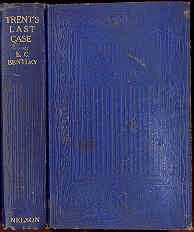Trent's Last Case
|
Cover of the fourth Nelson edition, 1917 | |
| Author | Edmund Clerihew Bentley |
|---|---|
| Country | United Kingdom |
| Language | English |
| Genre | Mystery, detective fiction |
| Publisher | Nelson |
Publication date | 1913 |
| Pages | 375 (hardcover 1st edition) |
| Followed by | Trent's Own Case (1936) |
Trent's Last Case is a detective novel written by E.C. Bentley and first published in 1913. Its central character reappeared subsequently in the novel Trent's Own Case (1936) and the short-story collection Trent Intervenes (1938).[1]
Plot summary
Trent's Last Case is actually the first novel in which gentleman sleuth Philip Trent appears. The novel is a whodunit with a place in detective fiction history because it is the first major sendup of that genre: Not only does Trent fall in love with one of the primary suspects—usually considered a no-no—he also, after painstakingly collecting all the evidence, draws all the wrong conclusions.
Convinced that he has tracked down the murderer of a business tycoon who was shot in his mansion, he is told by the real perpetrator over dinner what mistakes in logical deduction he has made in trying to solve the case. On hearing what really happened, Trent vows that he will never again attempt to dabble in crime detection.
Reception
In his critique of the mystery genre, The Simple Art of Murder, Raymond Chandler ridiculed some plot points that he considered preposterous: "I have known relatively few international financiers, but I rather think the author of this novel has (if possible) known fewer."
According to Aaron Marc Stein in his introduction to the 1977 edition, published by University Extension of UCSD: "At the risk of bringing down on his memory the wrath of the Baker Street Irregulars it must be recorded that Bentley had reservations about even the Conan Doyle originals. He deplored the great detective's lack of humor and he was irritated by the Sherlockian eccentricities.... Bentley had the idea of doing a detective who would be a human being and who would know how to laugh."
Film
The novel was adapted into a silent movie directed by Richard Garrick in 1920.
A second silent adaptation was made by Howard Hawks in 1929.The most recent film adaptation of Trent's Last Case was directed in 1952 by Herbert Wilcox. The 1952 film starred Michael Wilding as Trent, Orson Welles as Sigsbee Manderson, and Margaret Lockwood as Margaret Manderson.
An excerpt of the book is recited in the movie Places in the Heart (1984). "Trent's Last Case" by E.C. Bentley. The only part we ever hear is this opening line: "Chapter 1. Bad News. Between what matters and what seems to matter, how shall the world we know judge wisely ..."
Stage adaptation
The book was adapted into a stage production by John Arden McClure, which premiered in January 2013 at Eastpointe's Broadway Onstage Live Theatre. It starred Daniel Woitulewicz as Cupples, Elizabeth Rager as Bunner, Stella Rothe as Mabel Manderson, Patrick John Sharpe as Marlowe, and Jack Abella as Sigsbee Manderson. John Arden McClure portrayed the title character.[2]
Release details
- 1913, UK, Nelson (ISBN NA), Pub date 1913, Hardback (1st edition)
- 1917, UK, Nelson (ISBN NA), Pub date 1917, Hardcover (4th edition)
- 2005, US, Kessinger Publishing, ISBN 1-84637-709-9, Pub date October 31, 2005, Paperback
- 2005, US, Echo Library, ISBN 978-1-84637-709-9, October 2005, Paperback
Notes
- Binyon, T. J.. Murder Will Out: The Detective in Fiction. Oxford & New York: Oxford University Press, 1989. pp. 56–58, 63-66, 122.
References
- ↑ Campbell, Carol (n.d.). "Mystery features detective who gets it wrong". Sunday-Gazette Mail (Charleston, WV). Retrieved 28 April 2015.
- ↑ Trent's Last Case, Broadway Onstage. Retrieved 28 April 2015.
External links
| Wikisource has original text related to this article: |
- Trent's Last Case at Project Gutenberg
- Trent's Last Case at Fantastic Fiction
- Trent's Last Case (1920) at the Internet Movie Database
- Trent's Last Case (1929) at the Internet Movie Database
- Trent's Last Case (1952) at the Internet Movie Database
| ||||||||||
| ||||||||||||||
